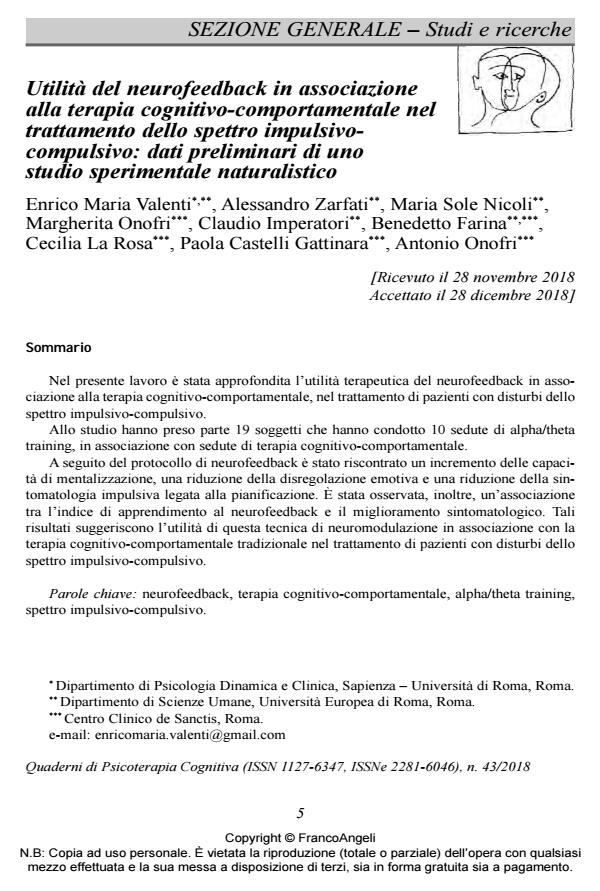Evaluation of the usefulness of neurofeedback in association with cognitive-behavioral therapy for the treatment of the impulsive-compulsive spectrum
Journal title QUADERNI DI PSICOTERAPIA COGNITIVA
Author/s Enrico Maria Valenti, Alessandro Zarfati, Maria Sole Nicoli, Margherita Onofri, Claudio Imperatori, Benedetto Farina, Cecilia La Rosa, Paola Castelli Gattinara, Antonio Onofri
Publishing Year 2019 Issue 2018/43
Language Italian Pages 21 P. 5-25 File size 117 KB
DOI 10.3280/QPC2018-043001
DOI is like a bar code for intellectual property: to have more infomation
click here
Below, you can see the article first page
If you want to buy this article in PDF format, you can do it, following the instructions to buy download credits

FrancoAngeli is member of Publishers International Linking Association, Inc (PILA), a not-for-profit association which run the CrossRef service enabling links to and from online scholarly content.
The aim of the present study was to investigate the usefulness of Neurofeedback in association with cognitive-behavioral therapy for the treatment of patients with impulsive-compulsive spectrum disorders. Nineteen subjects underwent 10 alpha/theta training sessions, in association with sessions of cognitive-behavioral therapy. Compared to pre-treatment condition, in the post-treatment an increase of the mentalization ability, a decrease of the emotional dysregulation and impulsivity was reported. Moreover, it has been observed an association between the Neurofeedback learning index and the decrease of emotional dysregulation. These results suggest the utility of this neuromodulation technique in association with the cognitive-behavioral therapy for the treatment of patients with impulsive-compulsive spectrum disorders.
Keywords: Neurofeedback, cognitive-behavioral therapy, alpha/theta training, impulsive-compulsive spectrum.
Enrico Maria Valenti, Alessandro Zarfati, Maria Sole Nicoli, Margherita Onofri, Claudio Imperatori, Benedetto Farina, Cecilia La Rosa, Paola Castelli Gattinara, Antonio Onofri, Utilità del neurofeedback in associazione alla terapia cognitivo-comportamentale nel trattamento dello spettro impulsivocompulsivo: dati preliminari di uno studio sperimentale naturalistico in "QUADERNI DI PSICOTERAPIA COGNITIVA" 43/2018, pp 5-25, DOI: 10.3280/QPC2018-043001